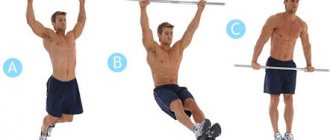Interest in long and rather boring cardio workouts is gradually fading away. Monotonous exercises for losing weight and staying in shape are being replaced by a relatively new trend in fitness - high-interval training.
The Tabata protocol training system, created by the Japanese doctor Izumi Tabata, has undergone a number of scientific tests. As a result, it was possible to establish that interval training has a stronger effect on aerobic and anaerobic performance of the body. A special set of exercises, the goal of which is to do as many specific movements as possible in a minimum period of time, helps burn fat and strengthen muscles. These results were obtained by specialists from the National Institute of Fitness and Sports in Tokyo directly under the guidance of the author of the Tabata training method.
The history of the appearance of training using the Tabata method
Doctor of Science and physiologist Izumi Tabata in 1996 began developing a new training system to increase endurance in athletes. The experiment lasted 6 weeks. Two groups of athletes took part in it: one trained for 1 hour 5 days a week, and the other trained 4 times a week, but only for 4 minutes.
It's time to compare the results of this experiment. Athletes from the first group showed an improvement in aerobic performance, which indicates a positive effect on the heart and blood vessels. But at the same time, the volume and strength of muscle tissue remained unchanged. There was no muscle gain. The level of endurance also remained at the original level.
And participants from the second group showed improvements in both aerobic and anaerobic performance. But the athletes trained less often and spent less time on it. And the results were many times better than those of athletes from the other group.
Benefits of the Tabata system
- In the Tabata system, training allows you to lose kilos in 4 minutes of exercise.
- It will reduce the appearance of cellulite, reduce volume, increase endurance and strengthen the muscles of the whole body.
- Classes are available to everyone.
- Ideal for a busy schedule and a lot of household chores, so the Tabata system is suitable for women on maternity leave and for busy businesswomen.
Tabata training rules
The results of an experiment conducted by Izumi Tabata in 1996 amazed even the most devoted fans of cardio training. It turned out that high-interval training allows you to effectively burn fat and develop the overall endurance of the body. But there is no need to practice for an hour or more - just 4 minutes is enough.
The Tabata round has the following structure:
- 20 seconds of intense training;
- 10 seconds rest.
The duration of the Tabata training session is 4 minutes. It includes 8 rounds. Exercises are allowed to be alternated at your own discretion. The interval between rounds can be 1-2 minutes. Then the total duration of the lesson will be 12-16 minutes.
The main rule of effective Tabata fitness training is to train at your maximum effort. Even if you are doing the exercises of the last round, you cannot slow down and spare strength. Otherwise, the training will be considered ineffective.
To maintain time intervals, it is more convenient to use special timers so as not to miss the end of a short rest period. Such programs can be downloaded and installed on any device. To maintain high performance, it is important to choose suitable sportswear that is made of high-quality fabrics and does not hinder movement.
Tabata Protocol
The Tabata protocol consists of the following exercise phases:
- sprint phase - 20 sec;
- rest phase - 10 sec;
- only 7-8 approaches for each exercise;
- respite between approaches - 1 minute.
Main subtleties:
- It is supposed to be performed at high speed, each time increasing the number of repetitions within 20 seconds, but not to the detriment of technique.
- Acceleration of metabolism begins within the first 3-4 days, and continues by inertia for another 24 hours.
- After just 1 cycle, the sweat will flow like a river, and the heart will beat at a fast pace.
- The peculiarity of the system is that, unlike strict diets that “eat up” muscle mass, the Tabata protocol sends a signal to the brain about the need for more muscle mass. It grows a little, and the layer of fat decreases.
- Popularly, training according to the Tabata system is called “prison training” because of the harsh intensity and the need for only 2 meters of territory.
What exercises can you do?
The Tabata protocol includes different exercises. Choose those that suit your fitness level.
The main exercises:
- sprint;
- punches and kicks;
- lunges;
- push ups;
- jumping out;
- squats;
- rowing on a simulator;
- kettlebell swings;
- lifting the body;
- swimming.
It is recommended to choose exercises that involve several muscle groups at once. You can practice in small groups or alone, including the use of instructional videos. Before training, it is recommended to familiarize yourself in detail with what Tabata is, the features of using this technique in fitness and its role in the overall health of the body.
Tabata exercises for beginners
Fat burning training is performed in a good mood, if desired, to music or in a group. Tabata for beginners is represented by exercises, the description of which follows with photos:
- Squats with wide legs. Place your feet shoulder-width apart and point your toes out to the sides. With your pelvis back and body tilted forward, squat down to the point where your pelvis and thighs are parallel to the floor. Make sure that your knees do not protrude beyond your toes. Return to the starting position without straightening your knees completely. Remember that the muscles in your legs are tense for the entire 20 seconds of execution. As you do this, extend your arms in front of your chest to maintain balance. You can complement and complicate squats by jumping up, and jumping with a deep squat will come out at a fast pace.
- Pushups. At first, it is difficult to do push-ups at a fast pace, so you can focus on your knees rather than on your toes. In addition, you can perform push-ups with emphasis on a hill: a sofa or bench.
- Leg bending from a sitting position. Sit on the floor, legs extended in front of you, body slightly tilted back, slight emphasis on your hands for balance. Lift your legs off the floor, transferring the load to your tailbone. From this pose, keeping your legs hanging, pull your knees as close to your chest as possible, returning to the beginning. Keep your back straight without arching your lower back. Do not lower your feet to the floor all the way.
- Lunges forward. The work is done 7-8 times for each limb. Stand straight, legs together, step with one leg as far as possible, bending the leg at the knee to a right angle. Also bend your back leg at the knee so that it almost touches the floor, focusing on your toes. The back is straight, the body is perpendicular to the floor, or slightly inclined forward. Over time, you can diversify the lunges with jumping.
- Scissors. Lie on the floor with your lower back pressed firmly against the floor, lift your legs off the surface and hold them at a 45-degree angle. Perform quick crossovers with your legs, and place your hands comfortably under your lower back or buttocks. There is no need to tear off the lower back. At the initial stage, you can raise your legs to a comfortable height.
- Push-ups for buttocks and triceps. Sit on the sofa, rest your palms on its edge, straighten your legs in front of you. From this position, bend your elbows and, moving them back, lower yourself above the floor. Then push up with your hands from the seat, lifting your pelvis up. To work your buttocks, squeeze your muscles at the top point and push your butt as high as possible.
- Raising the knees to the elbows. Stand up straight, bend your elbows and press them slightly to your chest. Next, raise your right knee to your left elbow, and vice versa. At the pace it will turn out to be jumps.
- Bridge on the shoulder blades. Lying on the floor, bend your knees and place them slightly wider than your shoulders. Raise your feet towards your buttocks, and your knees should be parallel to one another. Stretch your arms along the body. Squeeze your buttocks, lift them and your lower back off the floor and push them higher. Shoulders and shoulder blades are pressed to the floor.
This Tabata system for beginners is quite approximate; it can be varied and supplemented with strength exercises and other elements to your liking. Music for Tabata training should be fast and rhythmic, this will help you stay in good shape.
Tabata in fitness is highly intense, so you should not perform it if you have acute respiratory infections, ARVI, or any other weakness. The main thing is a positive attitude and willpower. For a detailed look at the exercises, watch the video below. You can ask any questions you may have in the comments.
Warm-up as a prevention of accidental injuries
Little experience in sports pushes people to act rashly. Some people overestimate the capabilities of their body, ignore the anatomical features of the structure of muscles, ligaments and the entire musculoskeletal system, but strive to achieve their goal in a short time. A common mistake is not warming up. If you start intense training from a resting state, injuries cannot be avoided.
Be sure to warm up before each session. Jumping rope, running in place or on a treadmill are suitable. Be sure to “warm up” your joints with circular movements, bending, and smooth rotation of the limbs. You should spend at least 7-10 minutes warming up.
How is Tabata different from cardio training?
Cardio training occurs with the active participation of oxygen. Such exercises are called aerobic. High-intensity Tabata training causes the body to suffer from oxygen deficiency, puts it into anaerobic mode, which takes a lot of energy and immediately switches to burning fat.
It is impossible to train for a long time in this mode. But to achieve the desired result, only 8 rounds of Tabata are enough. As a result, you get not only active fat burning, but also strengthening and muscle growth, effective training of the heart and blood vessels. Tabata training has a positive effect on endurance, as it forces the body to work with all its strength and teaches it to adapt to similar stress factors in the future.
What is Tabata?
This is a high-impact interval training program. It is performed with alternating loads and rest. Each individual approach takes about four minutes. It is recommended to conduct classes every other day.
Exercising allows you not only to get rid of fat deposits, but also to stimulate muscle growth. As a result, the body becomes not only slim, but also acquires a beautiful relief. The effect of exercise is much higher than that of regular aerobic exercise.
Who is Tabata training suitable for?
High interval training is suitable for trained people who regularly exercise and do not have serious problems with the heart or joints.
Tabata solves the following problems and helps achieve specific goals:
- intensive fat burning in a short period of time;
- increasing overall endurance;
- strengthening the heart muscle;
- acceleration of metabolic and hormonal processes in the body;
- the opportunity to get into good physical shape by spending 10-15 minutes a day doing exercises;
- noticeable increase in strength indicators;
- acceleration of muscle tissue growth, the ability to move to a more complex level of training in strength sports.
The technique requires composure and certain physical preparation. First make sure that there are no direct medical contraindications to intense exercise.
For whom Tabata training is contraindicated?
The Tabata technique is not for beginners in the sport. It is forbidden to immediately put high stress on the body. This can lead to injuries, exacerbation of chronic diseases, and surges in blood pressure. Tabata high interval training is suitable for those who regularly engage in cardio training or strength sports for at least 2-3 months.
The technique has the following contraindications:
- acute and chronic pathologies of the heart and blood vessels;
- injuries, inflammatory and destructive processes in joints;
- excess weight, in which you cannot perform exercises due to excessive stress on the joints;
- following a low-carbohydrate diet, which is accompanied by a lack of strength and energy;
- pregnancy;
- anemia, physical weakness, dizziness;
- instability of blood pressure.
Training is carried out when you are feeling well. If you have headaches, high blood pressure, or acute pain in the joints, it is better not to exercise for a while. But after high-intensity training, muscle pain occurs in the first months. They can be quite intense, especially for beginners. The reason for their appearance is the body’s natural reaction to the destruction of muscle fibers.
As a result, protein fragments are formed that absorb protective cells and release products that cause short-term pain. It is important to be able to distinguish pathological pain syndrome from physiological one. If you have any doubts, you should visit a traumatologist or orthopedist, conduct X-ray diagnostics or a modern MRI examination.
Temporary contraindications
The desire to go towards the intended goal, not paying attention to certain signals from the body, can end in failure. There are temporary conditions in which exercise is contraindicated. Otherwise, you can harm your health.
Tabata training is not carried out for the following conditions and disorders:
- increased body temperature;
- exacerbation of any chronic pathologies;
- headache;
- menstruation;
- recent injuries to the musculoskeletal system;
- severe fatigue;
- dizziness;
- increase or excessive decrease in blood pressure;
- decrease in hemoglobin;
- problems with coordination of movements;
- drowsiness.
High interval training can cause dizziness, especially in people with poor coordination. If you are not feeling well, reschedule the class for another day. Before training, you can measure your blood pressure and pulse. Sometimes abnormalities in the functioning of the heart and blood vessels do not manifest themselves at all, but can cause complications during intense exercise.
Tabata training provides maximum stress on different muscle groups, joints and all body systems. High-intensity training is not for everyone. For people without certain sports training, it can undermine their health.
The optimal age for using the technique is 25-40 years. If you already have joint problems, you should not choose Tabata. This is not a physical therapy method. Intense, high-speed exercise is not suitable for damaged joints with active degenerative changes.
Frequency of classes
The frequency of high-intensity training depends on your main goals. Those who want to lose weight are recommended to perform 8 rounds with a break of no more than 1-2 minutes - 3-4 times a week. Exercising daily is not recommended, as this leads to signs of overtraining and can reduce strength indicators.
To maintain physical fitness, Tabata training is recommended to be combined with strength training. Try doing high interval exercises 5-10 minutes after your main workout instead of standard cardio. This will improve strength performance and accelerate muscle gain.










